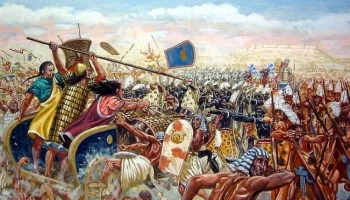Today we are introducing two more contributors to the Bible and Violence Project: Luis A. Quiñones-Román and Lena-Sofia Tiemeyer.
Luis A. Quiñones-Román is Ph.D. candidate in Hebrew Bible/Old Testament in the School of Divinity, University of Edinburgh (Scotland). Luis was born in Ponce, Puerto Rico. He obtained two Bachelor’s degrees, one in Biblical Studies from Mizpa Pentecostal University (Puerto Rico) and one in History of the Americas from the University of Puerto Rico. Luis has also completed two Master’s degrees: one in Divinity from Princeton Theological Seminary (USA) and the second in Bible and the Ancient Near East from the Hebrew University of Jerusalem (Israel). As a researcher, he is primarily interested in cuneiform laws, biblical laws, sexual violence, source criticism, Pentateuch studies, and Pentecostal studies. Luis is one of two contributors writing on Violence in the General Letters.

My chapter on the General Letters of the New Testament focuses on divine violence and will identify and analyse Hebrew Bible elements used in the Letters to sanction violence. It should be acknowledged that violence within these texts is literary violence, which is sometimes distinct from describing just physical violence. Given my focus, I will consider the passages that make specific references to divine violence. In Hebrews 10:26–31, for instance, the author uses “the law of Moses” to sanction divine violence: “whoever violates the law of Moses dies without mercy” (Heb 10:28). The author creates a concept of a “no mercy rule” for those who sin. The author then tries to reason with the audience: “How much worse punishment do you think will be deserved by those who have spurned the Son of God?” Again, the author evokes the Hebrew Bible, quoting Deuteronomy 32:35, “Vengeance is mine, I will repay.” By doing so, the author keeps amplifying fear, violence and their association with the Hebrew Bible. Hence, it says, “It is a fearful thing to fall into the hands of the living God” (Heb 10:31). This sounds very ominous and suggests psychological violence.
The General Letters use other elements as “weapons of fear” as well, promoting the notion that one should be frightened of God’s wrath. One example is reference to the destruction of Sodom and Gomorrah episode (2 Peter 2:4-10; Jude 1:7). So, when applying our “preliminary definition” in these texts, we see that divine violence is used by the author with the intentional aim “to control/oppress others.” Therefore, there is a pattern in authors’ sanctioning of divine violence, which occurs in three or four moves: 1) the author evokes an episode of the Hebrew Bible; 2) the author reasons with the audience; 3) the author re-evokes a passage of the Hebrew Bible; and then 4) creates a “rule/policy/doctrine.”
Discussion of this topic is vital, because the world we live in is a very hostile and violent place, particularly for minority groups. Human violence has been linked to divine violence throughout many ages. Humans use violence as a weapon to control and oppress others, and this is especially potent when it has the sanction of the deity. Divine violence may act as a deterrent for violent transgression, but it is also used as a model to justify more violence—as we see in some passages in the General Letters. I look forward to developing this more in the chapter I am writing.
(For more about Luis and his work, see here.)
_______________________________________________________________________
Lena-Sofia Tiemeyer is Professor of Old Testament Exegesis at Örebro School of Theology (Sweden). She specialises in Hebrew Bible and has mostly worked in the area of biblical prophecy. She has published a series of monographs: Priestly Rites and Prophetic Rage: Post-Exilic Prophetic Critique of the Priesthood (2006), For the Comfort of Zion: The Geographical and Theological Location of Isaiah 40–55 (2011), Zechariah and His Visions: An Exegetical Study of Zechariah’s Vision Report (2015), and Zechariah’s Vision Report and Its Earliest Interpreters: A Redaction-Critical Study of Zechariah 1–8 (2016). In parallel, Tiemeyer has written a shorter textbook on Ezra-Nehemiah (2017), and edited the Oxford Handbook of Isaiah (2020). As if that wasn’t enough, she has also published collections of articles, with focus on the relationship between prophecy and the cult of ancient Israel (2016), and on the Book of the Twelve (2020). Most recently, she published a commentary, Jonah through the Centuries (2021), which led her into the wonderous world of reception history. This interest has resulted in her forthcoming book devoted to the character of Jonathan in 1–2 Samuel. It is aptly called In Search of Jonathan (2023) and explores the literary afterlives of Jonathan in contemporary fiction, and what light these various portrayals can shed upon the biblical narrative. Lena-Sofia is writing a chapter on Violence and its suppression in the David story.

I am continuing to work on the book of Samuel in various ways. I am contracted to write a commentary on 1–2 Samuel and to co-edit the Oxford Handbook of King David. At the same time, I am developing further my interest in the literary afterlives of biblical characters in The Routledge Handbook of the Hebrew Bible in Contemporary Novels, Short Stories, and Poetry. It is this interest that my chapter for the Bible and Violence project builds on. I will explore how the violence in the David narrative has been treated in its later reception. Mostly, it has been toned down to ensure that David remains the hero of the story and to uphold the image of the ideal Davidic king. Most noticeably, rather than David raping Bathsheba, the sordid affair is often transformed into a mutual love story and/or Bathsheba is blamed for seducing David. In other cases, whole sections of the David narrative are removed, again to uphold a less violent and less savage hero. David’s sojourn among the Philistines is seldom mentioned, and the violence with which he seeks revenge upon his enemies is rarely elaborated on. At the same time, other retellings problematise David’s violence and make it the linchpin around which the plot revolves. In several literary retellings, David’s willingness to obtain 100 Philistine foreskins, which presumably meant killing the men beforehand, is understood as the turning-point in David’s life when he begins his descent into violence.
(For a complete list of Lena’s many publications, see here.)






